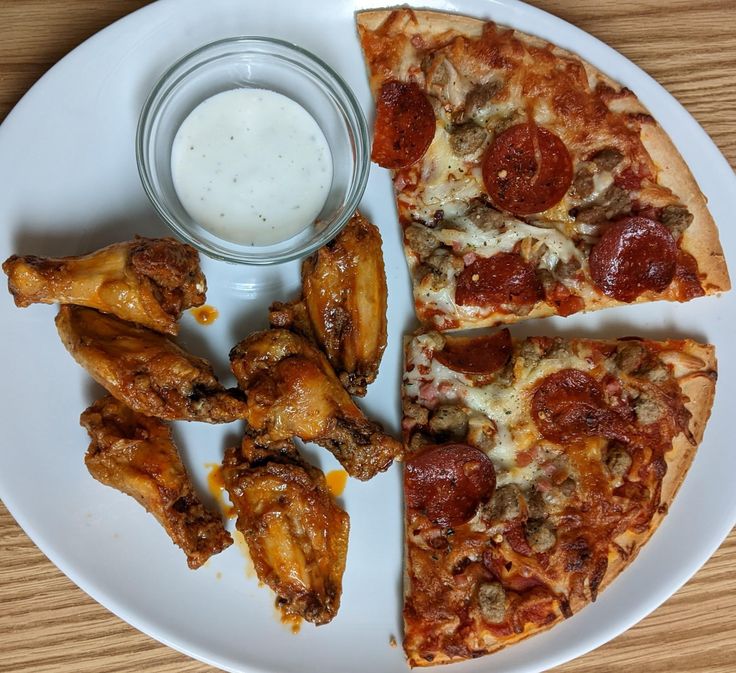Is Pizza or Wings Healthier?
It’s hard to declare a clear winner between pizza and wings as “healthier,” as both depend heavily on preparation and portion size. Here’s a quick breakdown:
Calories: Generally, wings can be lower in calories, especially without fried coatings or dips. A typical serving (6-8 wings) packs around 400-600 calories, while a slice of pizza can reach 300-500.
Nutrients: Pizza often offers more fiber and micronutrients like vitamins and minerals due to its dough and vegetable toppings. However, skinless, baked chicken wings can be a good source of protein.
Fats: Both can be high in unhealthy fats depending on preparation. Fried wings and cheese-heavy pizzas pack saturated fat. Opt for baked/grilled wings and pizzas with lean protein and veggie toppings for a healthier choice.
Portion control: This is key! Overindulging in either can negate any potential health benefits. Enjoy both in moderation as part of a balanced diet.
Introduction
When it comes to indulging in delicious comfort food, few options rival the satisfaction of sinking your teeth into a piping hot pizza or savoring the crispy goodness of chicken wings. But amidst the enjoyment, many health-conscious individuals find themselves pondering a crucial question: which of these beloved treats is the healthier choice?
Also, read about Calories for Spicy Tuna Roll
Understanding Pizza
Ingredients and Nutrition
Pizza, a culinary masterpiece originating from Italy, typically consists of a crust topped with tomato sauce, cheese, and various toppings such as meats, vegetables, and herbs. While ingredients can vary widely, common components include carbohydrates from the crust, proteins from the cheese and meat toppings, and vitamins and minerals from vegetable toppings.
Health Considerations
Despite its delectable appeal, pizza can be a nutritional minefield, particularly when loaded with high-fat meats and excessive cheese. The caloric content of pizza can vary significantly based on toppings and portion size, with traditional varieties often containing high levels of saturated fat and sodium, which are linked to various health issues when consumed in excess.
Decoding Chicken Wings
Ingredients and Nutrition
Chicken wings, a popular appetizer or main dish, are typically deep-fried and coated in a savory sauce. While they provide a good source of protein from the chicken, their nutritional profile can be compromised by the frying process and high-calorie sauces.
Health Considerations
While chicken wings offer protein, they are often high in calories, saturated fats, and sodium, especially when served with rich sauces like buffalo or barbecue. Consuming them regularly may contribute to weight gain and increase the risk of heart disease and other health problems associated with a high-fat diet. Discover more about How Many Calories in a Chicken Wingette

Comparing Pizza and Chicken Wings
Caloric Content
Both pizza and chicken wings can vary widely in caloric content depending on serving size and ingredients. However, on average, pizza tends to have a higher caloric density due to its carbohydrate-rich crust and generous cheese toppings.
Fat Content
Pizza and chicken wings can both be significant sources of fat, especially saturated fat if they are prepared with cheese or deep-fried, respectively. Opting for leaner protein toppings and lighter cooking methods can help reduce fat content in both dishes.
Protein Content
While chicken wings are inherently rich in protein due to their chicken base, pizza can also provide a substantial amount of protein, especially if topped with meat or cheese. However, the protein quality and quantity may vary based on ingredient choices.
Carbohydrate Content
Pizza crust is primarily composed of carbohydrates, contributing to its energy-dense nature. Chicken wings may contain some carbohydrates from breading or sauce, but they are generally lower in carbs compared to pizza.
Sodium Content
Both pizza and chicken wings can be high in sodium, particularly if they are processed or prepared with salty ingredients like cured meats or sauces. Excessive sodium intake is associated with hypertension and other cardiovascular issues.
Health Implications of Pizza Consumption
Potential Health Benefits
Despite its reputation as a guilty pleasure, pizza can offer nutritional benefits when prepared with wholesome ingredients like whole wheat crust, fresh vegetables, and lean proteins. These components can provide essential nutrients such as fiber, vitamins, and minerals.
Potential Health Risks
On the flip side, indulging in greasy, high-calorie pizza loaded with processed meats and excessive cheese can contribute to weight gain, elevated cholesterol levels, and increased risk of chronic diseases like diabetes and heart disease.

Health Implications of Chicken Wings Consumption
Potential Health Benefits
Chicken wings can be a good source of protein, which is essential for muscle growth, repair, and overall health. Choosing grilled or baked wings over deep-fried varieties can help reduce the fat and calorie content, making them a more nutritious option.
Potential Health Risks
However, consuming chicken wings regularly, especially when deep-fried or drenched in high-calorie sauces, can negate their nutritional benefits and contribute to health issues like obesity, high cholesterol, and cardiovascular disease.
Making Healthier Choices
Tips for Choosing Healthier Pizza Options
- Opt for thin crust or whole wheat crust for added fiber and fewer calories.
- Load up on vegetable toppings like spinach, bell peppers, and mushrooms for added nutrients and flavor.
- Choose lean protein toppings like grilled chicken or shrimp instead of fatty meats like sausage or pepperoni.
- Go easy on the cheese or opt for a lighter cheese option like part-skim mozzarella.
Tips for Choosing Healthier Chicken Wings
- Select grilled or baked wings instead of fried to reduce fat and calorie intake.
- Choose sauces or marinades with lower sugar and sodium content.
- Pair wings with a side of fresh vegetables or a salad to add nutritional value and balance to your meal.
- Limit portion sizes and enjoy wings in moderation as an occasional treat rather than a staple of your diet.
Conclusion
In the eternal debate of pizza versus chicken wings, there is no clear winner in terms of healthiness. Both can be enjoyed in moderation as part of a balanced diet, but it’s essential to make mindful choices and opt for healthier preparation methods and ingredients to minimize the potential negative health impacts. By being conscious of portion sizes, ingredient choices, and cooking methods, you can savor the flavors of your favorite comfort foods without compromising your health.
FAQs
1. Can pizza be part of a healthy diet?
Absolutely! Pizza can be a nutritious meal choice when prepared with wholesome ingredients like whole grains, vegetables, and lean proteins.
2. Are chicken wings high in protein?
Yes, chicken wings are a good source of protein, but they can also be high in fat and calories, especially when deep-fried or coated in rich sauces.
3. How can I make pizza healthier?
You can make pizza healthier by opting for whole wheat crust, loading up on vegetables, choosing lean protein toppings, and going easy on the cheese.
4. What’s the healthiest way to cook chicken wings?
Grilling or baking chicken wings is the healthiest cooking method as it reduces the amount of added fat and calories compared to deep-frying.
5. Can I enjoy pizza and chicken wings on a diet?
Yes, you can enjoy pizza and chicken wings in moderation as part of a balanced diet. Just be mindful of portions.
Meet Charles, a seasoned fashion designer with three years of industry expertise and the driving force behind the vibrant urbansoutfitter.com. As the dedicated admin and owner, Charles brings a unique blend of creativity and insight to this fashion-centric platform. From the latest trends to the intricacies of design, urbansoutfitter.com, under Charles’s stewardship, serves as a dynamic space where fashion enthusiasts can immerse themselves in diverse and captivating fashion-related topics.

